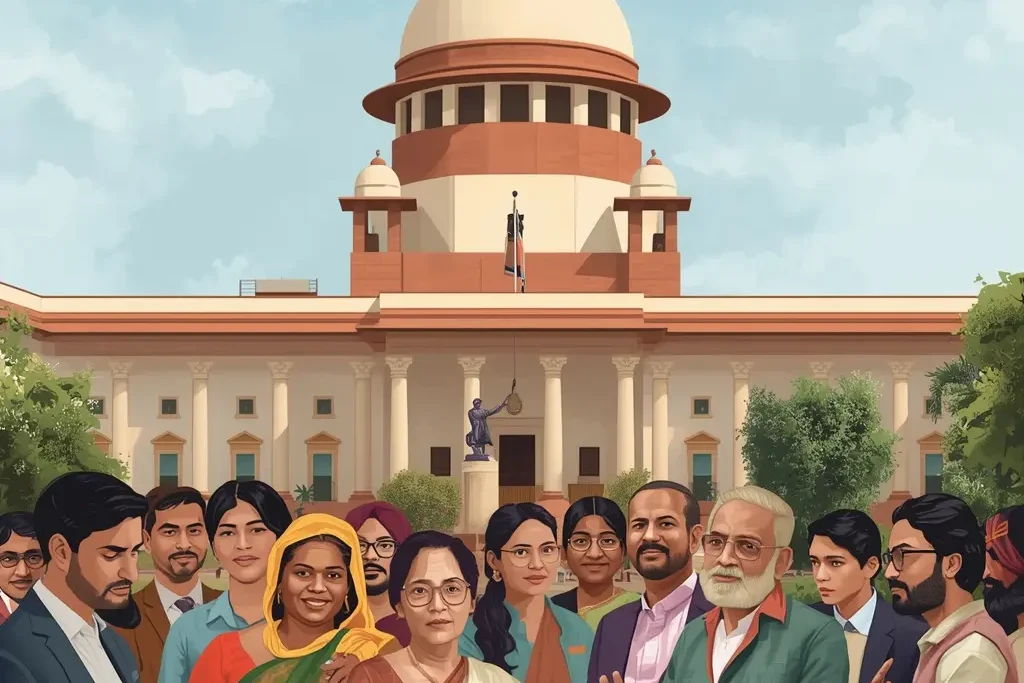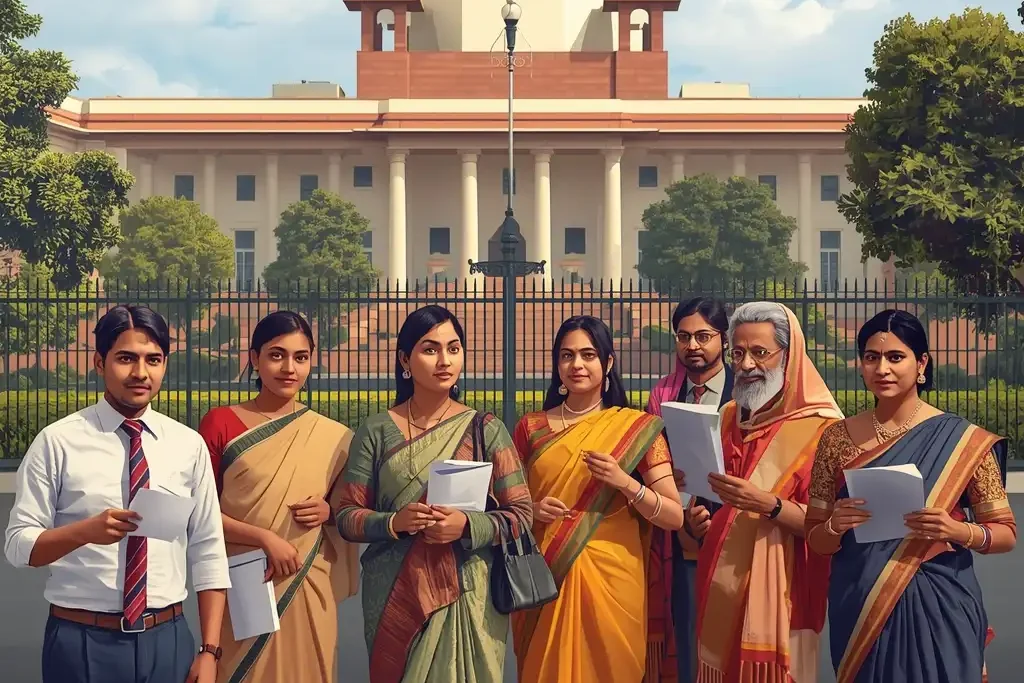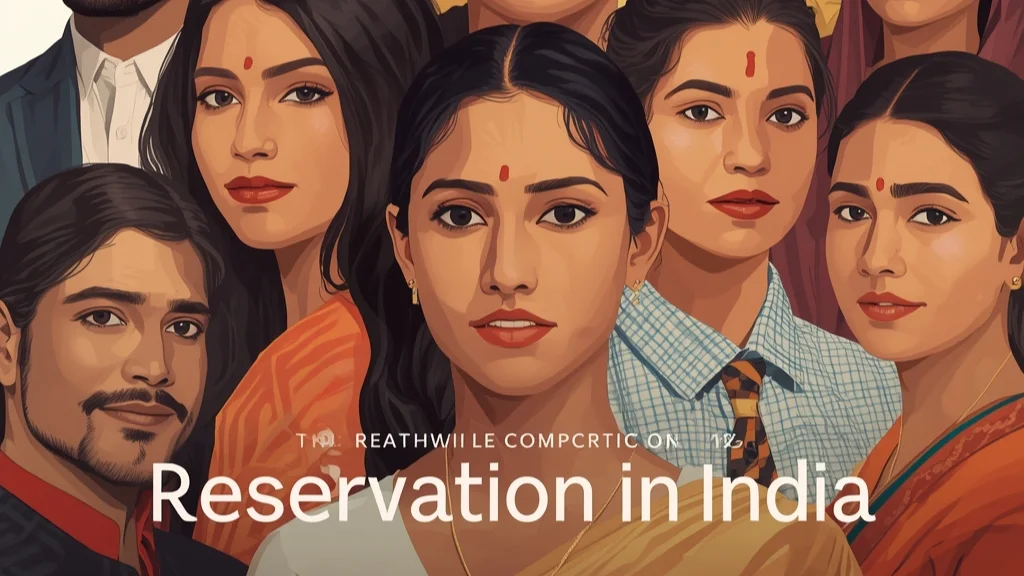Introduction
In this article we provides a comprehensive overview of how India’s reservation system has evolved through the lens of the judiciary. It explores the historical roots, constitutional provisions, and the purpose behind reservation as a tool for promoting equality and social justice.
The article discusses major landmark judgments such as State of Madras vs. Champakam Dorairajan (1951), Indra Sawhney vs. Union of India (1992), and the EWS Reservation case (2022), which have shaped the modern interpretation of affirmative action in India.
What is the meaning and purpose of reservation in India?

Reservation in India is one of the most significant social justice mechanisms designed to correct historical inequalities and discrimination faced by certain communities. It ensures representation for Scheduled Castes (SC), Scheduled Tribes (ST), Other Backward Classes (OBC), and more recently, the Economically Weaker Sections (EWS) in education, employment, and political institutions. The core purpose of Reservation in India is to provide equal opportunities and uplift socially and educationally disadvantaged groups who were historically marginalized under the caste system.
The notion of reservation in India is based on the principle of equality that is embedded in the Indian Constitution. Articles 15 and 16 of the Constitution clearly permit the State to implement special measures for the upliftment of marginalized groups. Consequently, reservation is not just a benefit—it is a constitutional protection aimed at promoting social inclusion and equal opportunities.
Which are the major landmark judgments related to reservation in India?
Over the years, the Supreme Court of India has delivered several landmark judgments on reservation that have shaped the scope and application of the policy. One of the earliest cases was State of Madras v. Champakam Dorairajan (1951) — the Supreme Court struck down caste-based reservation in educational institutions in that case, leading to the First Constitutional Amendment which introduced Article 15(4).
Another significant ruling came in M.R. Balaji vs. State of Mysore (1962). In that case the Court observed that the total reservation should not exceed 50% to maintain equality for all. This principle was later reaffirmed in subsequent Supreme Court reservation cases, establishing a constitutional balance between merit and social justice.
Here’s a shorter, simple table of major landmark judgments on reservation in India 👇
| Year | Case Name | Key Impact |
|---|---|---|
| 1951 | State of Madras vs. Champakam Dorairajan | Led to First Constitutional Amendment (Article 15(4)). |
| 1962 | M.R. Balaji vs. State of Mysore | Set 50% limit on reservations. |
| 1992 | Indra Sawhney vs. Union of India | Upheld 27% OBC quota; introduced “creamy layer.” |
| 2006 | M. Nagaraj vs. Union of India | Validated promotion quotas with conditions. |
| 2022 | Janhit Abhiyan vs. Union of India | Upheld 10% EWS reservation. |
The verdict in the case of Indra Sawhney vs. Union of India (1992), commonly known as the Mandal Commission case, is a significant decision in the development of Reservation Policy in India. It upheld a 27% reservation for Other Backward Classes (OBCs) in central government jobs but capped the total reservations at 50%. Furthermore, the Court established the concept of the “creamy layer,” which excludes the wealthier members of OBCs from availing reservation benefits.
What does the Constitution say about reservation in India?

The Constitutional Provisions on Reservation are mainly found in Articles 15, 16, 17, and 46.
- Article 15(4) allows the State to make special provisions for the advancement of socially and educationally backward classes or for SCs and STs.
- Article 16(4) empowers the State to provide reservation in public employment for any backward class that is not adequately represented.
- Article 17 abolishes untouchability, reinforcing the constitutional intent toward social equality.
- Article 46 directs the State to promote the educational and economic interests of weaker sections.
In addition, Article 330 and 332 provide political reservation for SCs and STs in Parliament and State Assemblies. These provisions ensure that marginalized communities have a voice in decision-making. Over time, landmark judgments on reservation have clarified and upheld these constitutional guarantees.
How did the Indra Sawhney case (Mandal Commission) affect reservation laws?
The indra sawhney & union of india case (1992) is a considerable terrific court ruling related to affirmative motion in india. Often called the mandal fee case, it substantially altered the framework of the usa’s reservation coverage.
The case upheld 27% reservation for OBCs in central government services, which was recommended by the Mandal Commission. However, it imposed certain restrictions:
- Total reservation should not exceed 50%.
- The “creamy layer” (economically advanced OBCs) should be excluded.
- Reservation should not be extended to promotions (though later amended by Parliament).
This judgment was a turning point because it balanced the principle of equality of opportunity with social justice. The Indra Sawhney case also emphasized that Reservation in India is not a tool for perpetuating caste divisions but for eradicating them through empowerment.
What is the difference between SC, ST, and OBC reservation?
The Reservation Policy in India categorizes beneficiaries based on the degree of historical disadvantage they have faced.
- Scheduled Castes (SC): These are communities historically subjected to untouchability and extreme social exclusion. They receive 15% reservation in education and government jobs.
- Scheduled Tribes (ST): These are indigenous communities living in remote or forested areas who faced social and economic marginalization. They are entitled to 7.5% reservation.
- Other Backward Classes (OBC): Identified as socially and educationally backward, OBCs receive 27% reservation in public employment and educational institutions.
Here’s a shorter vertical comparison of SC, ST, and OBC reservation:
| Category | Details |
|---|---|
| SC | Reservation: 15% Context: Untouchability and caste discrimination Purpose: Social upliftment |
| ST | Reservation: 7.5% Context: Tribal marginalization Purpose: Economic and educational inclusion |
| OBC | Reservation: 27% Context: Socially and educationally backward Purpose: Equal opportunities |
This structure ensures inclusivity across different social strata. Constitutional Provisions on Reservation empower the government to periodically review and update these lists. The goal remains consistent—to promote equity and reduce centuries-old inequalities embedded in society.
Is the 10% EWS reservation constitutional in India?

The 103rd Constitutional Amendment Act, 2019, established the reservation for Economically Weaker Sections (EWS). This amendment allocates a 10% quota for individuals from the general category who are economically disadvantaged and do not benefit from the existing reservations for SC, ST, or OBC.
This move marked a major shift in the Reservation Policy in India, as it introduced economic criteria alongside social and educational backwardness. Critics argued it diluted the essence of caste-based affirmative action, while supporters claimed it broadened equality.
In 2022, the Supreme Court of India affirmed the constitutionality of the EWS reservation through a 3:2 majority decision. The Court concluded that the amendment does not breach the fundamental structure of the Constitution because it seeks to advance economic equality, which is a valid constitutional objective. Therefore, the EWS quota serves as a significant ruling on reservation, broadening the parameters of affirmative action in India.
How has the Supreme Court shaped the reservation policy in India?
The Supreme Court has significantly influenced the development and clarification of the Reservation Policy in India. In its numerous pivotal rulings regarding reservation, it has continually interpreted constitutional clauses to promote both equity and inclusiveness.
Apart from Indra Sawhney (1992), the Court’s verdict in M. Nagaraj vs. Union of India (2006) upheld the validity of reservations in promotions but required states to collect quantifiable data proving backwardness and inadequate representation. Similarly, in Jarnail Singh vs. Lachhmi Narain Gupta (2018), the Court simplified the process by removing the requirement to demonstrate backwardness again for SCs and STs, recognizing it as already established.
| Year | Case | Impact |
|---|---|---|
| 1951 | State of Madras vs. Champakam Dorairajan | Led to First Constitutional Amendment. |
| 1962 | M.R. Balaji vs. State of Mysore | Set 50% cap on reservations. |
| 1992 | Indra Sawhney vs. Union of India | Upheld 27% OBC quota; introduced “creamy layer.” |
| 2006 | M. Nagaraj vs. Union of India | Validated promotion quotas with conditions. |
| 2018 | Jarnail Singh vs. Lachhmi Narain Gupta | Simplified promotion reservations for SC/ST. |
| 2022 | Janhit Abhiyan vs. Union of India | Upheld 10% EWS reservation. |
These Supreme Court reservation cases reflect how judicial interpretation has evolved to preserve the delicate balance between equality of opportunity and social justice. They ensure that Reservation in India continues to adapt to the country’s changing socio-economic realities while staying true to constitutional principles.
FAQs
What is the reservation percentage in India?
Total reservation in India is generally 50%, with some exceptions like Tamil Nadu.
Who gave 27% reservation to OBC?
The Mandal Commission recommendation, upheld by the Supreme Court in Indra Sawhney vs. Union of India (1992).
How does Tamil Nadu have a 69% reservation?
Tamil Nadu’s state law allows 69% total reservation, exceeding the Supreme Court’s usual 50% limit.
Which caste has the highest reservation?
OBCs have the highest reservation at 27% in central government jobs and educational institutions.
Which state has no reservation in India?
Goa has minimal caste-based reservations compared to other states; most communities have general category status.
Conclusion
The journey of Reservation in India reflects the nation’s long struggle toward achieving equality and justice. Guided by Constitutional Provisions on Reservation and refined through landmark judgments on reservation, this policy remains a cornerstone of India’s social framework. It ensures that historically disadvantaged communities have fair access to education, employment, and political participation.
While debates continue over merit versus reservation, the essence of the policy lies in creating a level playing field for all citizens. The evolving jurisprudence—from Champakam Dorairajan to Indra Sawhney and EWS reservation—shows that the Indian judiciary has consistently sought to uphold the constitutional values of equality, fraternity, and justice.
Ultimately, the Reservation Policy in India is not just about numbers or quotas; it is about the idea of inclusion, dignity, and empowerment. Through Supreme Court reservation cases, India has demonstrated that law can be a powerful instrument for social transformation and equality for all.
Further Readings:
- Exclusive Funding Opportunities for Startups & Entrepreneurs
- UPS to NPS Migration 2025
- A Complete Guide to the New Indian Penal Codes

